The Voyagers' Odyssey
By Stamatios M. Krimigis, Robert B. Decker
A mission intended to last a mere four years has extended into a decades-long journey to interstellar space.
A mission intended to last a mere four years has extended into a decades-long journey to interstellar space.

DOI: 10.1511/2015.115.284
When the two Voyager spacecraft were launched in 1977, they followed a legacy of space exploration that was only two decades old, but which had accomplished much in that time. The first spacecraft to orbit Earth, Sputnik 1, was launched in 1957, and NASA’s Mariner 2 spacecraft passed Venus on December 14, 1962. Mariner 4, which swung by Mars on July 15, 1965—some 50 years ago—was the first to carry a camera. Pioneer 10 and 11’s flybys of Jupiter in the early 1970s, and Pioneer 11’s continuation to Saturn in 1979, gave a first glimpse of the complexity of these two planetary systems. The outer planets (Jupiter, Saturn, Uranus, and Neptune) as a group, however, remained basically unexplored until the two Voyager spacecraft arrived.

After the Voyagers’ successful flybys of all four major outer planets, which they completed when Voyager 2 departed Neptune in 1989, follow-on tasks could be taken on. The spacecraft began what has been dubbed the Voyager Interstellar Mission, with the objective of exiting the hot, extended atmosphere of the Sun, called the solar wind, and reaching the relatively cold gas in the local interstellar medium, the material filling the space between stars in a galaxy. Such a feat would give us our first direct experience of interstellar space. At the time of the Voyagers’ launch, none knew how far this boundary would be, but estimates ranged from just beyond the orbit of Jupiter at 5 astronomical units (where one astronomical unit equals 150 million kilometers, the distance from the Sun to the Earth) to well beyond 50 astronomical units. As it turned out, the boundary was a lot farther than anyone had imagined.
As the solar wind travels out from the Sun, the plasma (electrons and ionized atoms) blows out a bubble that is confined by backward pressure from the galactic magnetic field; this region of influence of the solar wind is called the heliosphere. The galactic region of local interstellar space is dominated by plasma and cosmic rays originating from the explosions of supernovae over the last few million years. The surface where the radial flow of the solar wind brakes from about 300 kilometers per second to about 100 kilometers per second is called the termination shock. In this location, the solar plasma is deflected in azimuth and elevation, while its temperature increases from 10,000 to about 100,000 kelvin, creating what is called the heliosheath region. Eventually the radial plasma flow is expected to stop altogether; beyond that distance lies the heliopause, the border between the Solar System’s plasma and magnetic field and those of the galaxy. Past this point, there is the possibility of a bow shock, a bit like the ripples of water created by a boulder in a stream, created by the Sun’s movement, and the whole heliopause with it, through the interstellar medium. At the opposite side of the heliopause, there could form a cometlike tail of low-density plasma.
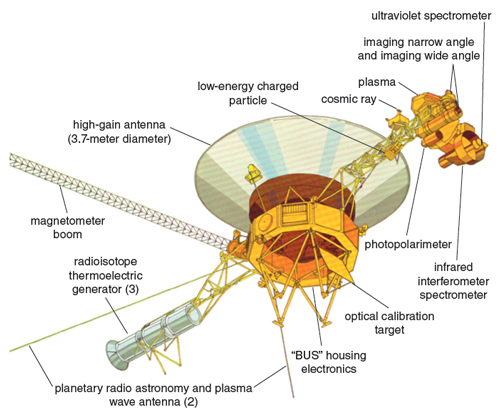
The Voyager spacecraft operated a full complement of instruments through all four planetary encounters, but for the interstellar mission only five are necessary and powered (see the figure above). The others have been switched off to conserve the dwindling power supply from the probes’ radioisotope thermal generators. The magnetometer, mounted at the end of a 13-meter boom, makes detailed measurements of the magnitude and direction of the ambient magnetic field. The plasma wave antennas measure the electric field components of plasma waves over the frequency range of 10 hertz to 56 kilohertz. The final three instruments are all mounted on the science boom: The cosmic ray sensor measures the intensity, composition, and spectra of high energy cosmic rays and relativistic electrons; the low energy charged particle detector measures energetic particles at lower energies than the cosmic ray sensor, plus their flow direction; and the plasma sensor detects the properties of solar wind ions and electrons at energies as low as a few electron volts. (An electron volt is the energy an electron gains when it travels through an electrical potential difference of 1 volt; it’s also equivalent to 1.6 × 10–19 joules.)
The last instrument is still functioning only on Voyager 2 (although it’s worth noting that after 38 years, that instrument has been the only one to fail). Each of the instruments performs a specific set of measurements, all of which are necessary to fully characterize the interplanetary and local interstellar medium.
Getting the Voyagers on the path to their mission was no mean feat. The finite thrust of rockets taking off from Earth prevents them from propelling significant payloads much beyond the orbit of Jupiter, so a technique known as gravity assist is employed to accelerate spacecraft to higher speeds as well as change their direction. In this process, a well-planned flyby can use another planet’s gravity to act like a slingshot, and add momentum to increase the energy of a spacecraft’s orbit and propel it outward in the Solar System, much farther away from the Sun than its launch vehicle would have been capable of doing. A retrograde flyby, where the craft travels in the opposite direction of the planet’s spin, can be used to subtract momentum and decrease energy, a move that can be used to change a craft’s direction. If the flyby planet is at just the right part of the sky, then the gravity assist can send the spacecraft to another planet farther out. Gary Flandro of the Jet Propulsion Laboratory pointed out in 1965 that the outer planets lined up once every 175 years in such a way that a spacecraft could be propelled from one planet to the next in record time, and also surpass the Solar System escape velocity of about 7 kilometers per second, meaning that the Sun’s gravity is no longer a factor on the spacecraft velocity. This opportunity would occur for a 1977 launch, whereupon detailed spacecraft and trajectory designs were undertaken at the Jet Propulsion Laboratory.
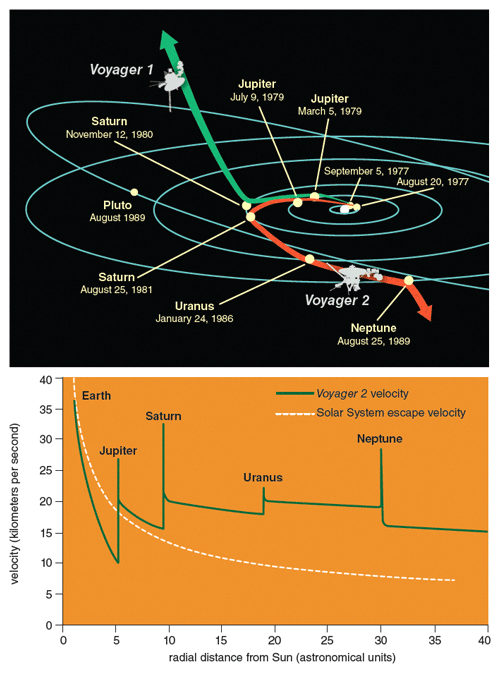
The science team decided early in the planning process that Voyager 1, which could have been targeted for a Pluto encounter after Saturn, should instead be directed to a close flyby of Titan, Saturn’s largest moon; it would then follow a heliocentric trajectory toward the general direction of the solar apex, the direction of the Solar System’s motion with respect to the local star group (see the figure above).
Voyagers' measurements found that the outer planets have peculiar magnetic fields, which have yet to be understood.
The Voyager 2 trajectory was designed to take full advantage of the planetary alignment with encounters of not only Jupiter and Saturn, but also Uranus and Neptune. The spacecraft received a velocity boost with respect to the Sun of about 10 kilometers per second at Jupiter, 4 kilometers per second at Saturn, 2 kilometers per second at Uranus, and –3 kilometers per second at Neptune; the last one robbed some velocity because of a retrograde flyby needed to enable a close encounter with Neptune’s moon Triton. However, Voyager 2’s heliocentric velocity of 15.6 kilometers per second still far exceeds the Solar System escape velocity.
The discoveries resulting from the planetary flybys of the Voyagers from 1979 through 1989 captivated the public imagination and demonstrated the excitement of robotic exploration like no other mission of the space era. The two spacecraft together revealed the complexity of the four planets, and unveiled the sheer beauty of worlds that had been only dimly perceived before.
Some of the findings of Voyager were totally unanticipated. For instance, their images of Jupiter’s moon Io showed lavas deposited via incessant volcanism, the first discovery of volcanism outside of our own planet. The power of Io’s largest volcano is at least tenfold that of any on Earth. Another Jovian moon, Europa, was found to possess a surface of solid ice crisscrossed by cracks many tens of kilometers long, with colors suggesting upwelling from an underlying liquid ocean. Ganymede was shown to have an icy surface with both old terrain, as well as younger features that indicate later tectonic activity. And Callisto was characterized by long crater chains and a very old surface.
The Voyagers also imaged the Great Red Spot on Jupiter, first seen by Galileo Galilei in the 17th century, a persistent hurricane-like feature nearly 2.5 times the size of Earth. Voyagers’ measurements also found that the outer planets have peculiar magnetic fields—as manifested in the tilt of their dipole axes with respect to their rotation axes, and their offsets from the center of their planets. For instance, Neptune has a tilt of 47 degrees and an offset of 55 percent. Such large values cannot be explained by current theories for the generation of planetary magnetism and have yet to be understood.
Although their images of planets are breathtaking, some of the Voyagers’ most enlightening data come from their measurements of the very small. During their interstellar mission, Voyager 1 and 2 have measured distributions of energetic electrons and ions. These measurements include, for example, low-energy ions, mainly protons, with energies of 0.14 to 0.22 million electron volts, which originate in the heliosphere (see figure below) and galactic cosmic ray protons with energies of more than 70 million electron volts. The low-energy ions have speeds of 3.0 to 3.7 astronomical units per day, which, although relatively slow compared to that of the galactic cosmic rays (at 67 to 172.8 astronomical units per day), are still much faster than the mean solar wind speed of 0.25 astronomical units per day. Thus, the low-energy ions are free to propagate over large distances along the spiral-shaped magnetic field of the solar wind, enabling them to move far from their source regions.
Voyager 1 and 2 spent their first 27 and 30 years, respectively, measuring phenomena in the solar wind. Energetic ions and electrons observed in the inner heliosphere originate mainly at the Sun during solar active years, when sunspot numbers are high. Charged particles accelerated by solar flares and at shock waves at the front edge of coronal mass ejections by the active Sun are called solar energetic particles. Charged particles accelerated at shock waves bounding the front and rear edges of solar wind stream interaction regions, called corotating interaction regions, form beyond a few astronomical units of the Sun during solar inactive periods. They tend to recur over several solar rotations with a period of about 26 days, as these regions rotate about the Sun like pinwheels.
Voyagers’ measurements of the intensities of both populations of ions decreased roughly as the inverse square of the radial distance from the Sun, until about year 2000. Another ion source known as pickup ions, which play a major role beyond a few tens of astronomical units, particularly at the termination shock and in the heliosheath, are interstellar neutral atoms (mostly hydrogen, helium, and oxygen) that become ionized as they drift into the heliosphere at about 25 kilometers per second. Protons from galactic cosmic rays originate mainly from sources outside the heliosphere, such as at shock waves formed when stars in our galaxy explode to become supernovae. Such particles that enter the heliosphere must fight against the outflowing solar wind, which carries a spiral magnetic field with superposed small-scale magnetic fluctuations and larger-scale disturbances from elevated levels of solar activity. Consequently, there is a steady increase in galactic cosmic ray intensity as the Voyagers move farther from the Sun toward the local interstellar medium, but with an 11-year solar-cycle variation because of the inverse correlation between sunspot number peaks and galactic cosmic ray peaks.
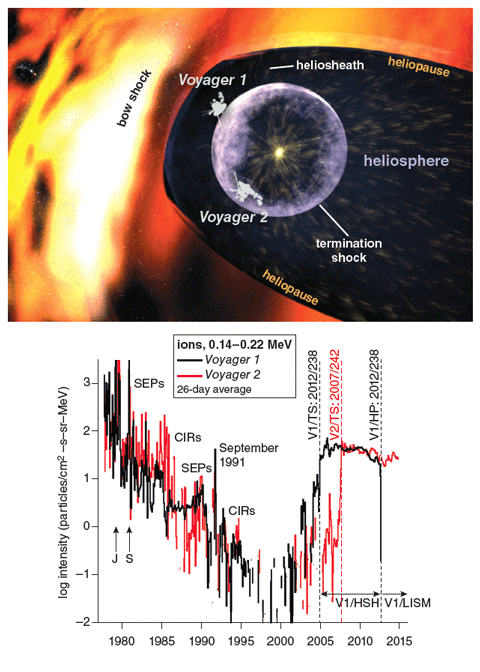
After the deep minimum of low-energy ion intensities reached in 1998–2000 (as shown in the bottom-image, above), ion intensities increased. Voyager 1 crossed the termination shock on December 16, 2004, at 94 astronomical units, and explored the heliosheath (about 30 astronomical units wide along the Voyager 1 path) for 8.2 years. We were warned of the impending termination shock crossing by precursor particles that had velocities highly collimated along the Sun’s spiral magnetic field, but they arrived from a direction opposite to that predicted. The explanation was that the termination shock is blunted in its nose region by the asymmetric pressure imposed on the heliosphere by the tilted magnetic field of the local interstellar medium.
Voyager 2, following its very different path, crossed the termination shock several times between August 29 and 31, 2007, at 83.65 astronomical units from the Sun. The multiple crossings are believed to have resulted either from waves on the termination shock surface or from quasi-periodic modification of its internal structure by nonthermal pickup ions. Voyager 2 is now in the heliosheath, about 22 astronomical units beyond the termination shock, and is heading toward the heliopause. The heliosheath is a relatively steady and, at least at the locations of the two Voyagers, uniform reservoir of low-energy ions with high intensities. The energies of protons measured in this reservoir extend from at least 0.03 to about 30 million electron volts.
The plasma sensor on Voyager 2 enabled measurements of the thermal plasma before and after the craft crossed the termination shock. However, based on the plasma data alone, the calculated sound speed behind the shock was less than the flow speed in that region, which implied that the termination shock was in fact not a shock in the technical sense that the preshock flow should be decelerated by the shock to a subsonic speed. Voyager investigators soon realized that the pressure of the nonthermal ions must be included in calculating the sound speed in the heliosheath, but these particles are well below the energy range accessible to the low energy charged particle instrument and the intensity measurable by the Voyager plasma sensor. We know that this distribution of shocked and heated pickup protons must exist in the heliosheath because it is this population of hot protons that undergo charge exchange with inflowing cold, neutral hydrogen atoms, and thus provide the energetic neutral atoms recently observed remotely by two other spacecraft, the Interstellar Boundary Explorer (IBEX) located at 1 astronomical unit and Cassini at 10 astronomical units.
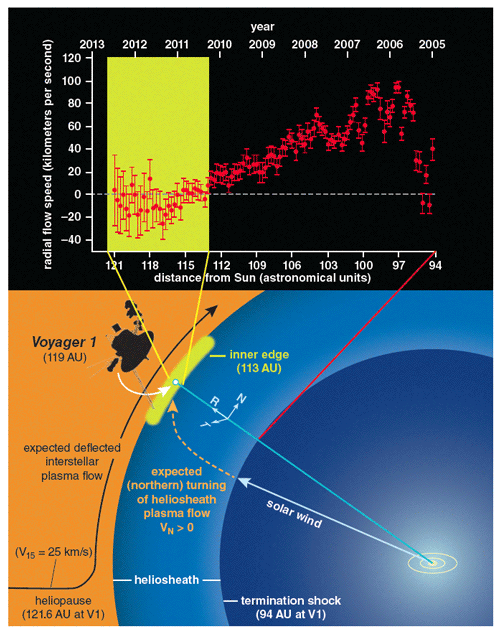
A remarkable finding from Voyager 1’s passage through the heliosheath was the unexpected evolution of the plasma flow velocity there. As shown in the figure at right, the radial component (labeled R) of the solar wind velocity is slowed and deflected across the termination shock, and expected in the heliosheath to acquire meridional (N) and azimuthal (T) components. The plasma detector on Voyager 1 has not functioned since 1981. However, the low-energy charged particle instrument measures low-energy ions in eight 45-degree sectors that cover a full circle lying in the R–T plane. In situations when the low-energy ions tended to move with the plasma, such as in the heliosheath, these directional data were used in lieu of plasma detector data to estimate the R-component and T-component of plasma flow in the heliosheath.
As Voyager 1 moved deeper into the heliosheath, the T-component remained small and relatively constant at about –20 to –40 kilometers per second, whereas the R-component decreased from a peak of 100 kilometers per second at 97 astronomical units, to 0 kilometers per second at 113 astronomical units. This change in itself would not be a surprise, because the radial velocity was expected to vanish just before the heliopause crossing to allow the heliosphere plasma to flow parallel to the heliopause surface. However, Voyager 1 measured this zero radial velocity for an additional 2 astronomical units and then entered a region from 115 to 121 astronomical units in which the velocity fluctuated, but was on average –15 kilometers per second. In other words, it is directed sunward, suggesting that the heliosheath plasma was somehow coupled to the inflowing local interstellar medium plasma.
We all wondered: What had happened to the heliosheath flow? Was radial flow being diverted into meridional flow?
To help answer this question, in early 2011 ground controllers instructed Voyager 1 to roll about the Earth-spacecraft line through about 90 degrees, and hold this attitude for several hours every few months to enable estimates of the meridional velocity. These rolls continue as Voyager 1 moves through the local interstellar medium. So far, the results show that meridional velocity was at most a few kilometers per second in 2011 and 2012, meaning that radial flow had not been diverted into the meridional direction. Several models have been advanced to explain the evolution of the plasma flow in this so-called stagnation region extending from 113 to 121 astronomical units. There is as yet no consensus that favors any one model over the others.
Despite the surprises encountered at the edge of the heliosheath, our expectation was that once the heliopause was crossed, the disappearance of solar wind plasma would be simply accompanied by an increase in galactic cosmic rays and a turn in the magnetic field direction to that estimated for the galactic field. The reality revealed by the Voyager measurements turned out to be quite different.
The galactic cosmic ray intensity increased in steps, first on May 7, 2012, then up and down starting on July 28, again on August 9, and finally on August 25 at a distance of 121.6 astronomical units from the Sun. The last increase was most pronounced along the direction of the field, but less so perpendicular to it. The expectation from theory was that galactic cosmic rays would not have a preferential direction in the local interstellar medium. Coincident decreases in solar particles also were not evenly distributed in direction.
In contrast to the galactic cosmic ray increases, particles escaped quickly along the field but much more slowly perpendicular to it. The magnetic field increased in magnitude coincident with the particle changes, but the direction stayed nearly constant during the short events and continuously so after the final discontinuity on August 25, 2012. Furthermore, the magnetic field magnitude reached a value more than four times that seen throughout the heliosphere.
The azimuthal direction of the solar magnetic field inside the cavity formed by the solar wind was expected to change to that of the north-south interstellar field, but did not. And the galactic cosmic rays have been anisotropic (not uniformly distributed), except for some intervals over the past year, and continue to exhibit this behavior to this day. These confusing details prompted a long-running debate on whether Voyager 1 was or was not in interstellar space that became a dispute between observations versus theory and modeling.
A long-running debate on whether or not Voyager 1 was in interstellar space became a dispute between observations versus theory and modeling.
On the one hand, the galactic cosmic rays increased as expected, but were anisotropic and their distribution was ordered by the magnetic field (both unexpected events). The solar material disappeared, as expected, but its escape was also ordered by the magnetic field, which was unexpected. And the magnetic field direction did not change to that estimated for the local interstellar medium—indeed, it remained nearly the same as that in the solar wind cavity, leading some to suggest that the boundary crossed on August 25, 2012, was not the real heliopause.
Initially it was assumed that the lack of directional change in the magnetic field following the heliopause boundary crossing could be taken as a proxy that there was still solar plasma present at the spacecraft’s location after August 25 (which was not possible for Voyager 1 to measure because of its inoperative plasma sensor). The counter to that argument was that solar material down to energies of 40,000 electron volts was undetectable, and at somewhat higher energies, the quantity was down by more than 10,000.
In fact, a variety of arguments, also based on energetic neutral atom images from the Cassini spacecraft in orbit around Saturn (a new technique that can image the entire sky remotely), suggested that solar material had probably disappeared at any energy. Those arguments led to an estimate for the location of the heliopause at 121 astronomical units, as observed. Then there was the persisting anisotropy of galactic cosmic rays that was not predicted by any theoretical model.
The missing measurements necessary to resolve the conundrum were plasma density, temperature, and direction, which the plasma detector would have provided. In April 2013, the plasma wave antennas, not having detected any wave activity for the past several years, began to see electron plasma frequency oscillations. These measurements can be converted to density, and that was found to be close to the estimated value expected for the relatively cold galactic plasma. By contrast, the density in the heliosphere, measured by Voyager 2 with its still-operating plasma detector, is about 50 times smaller.
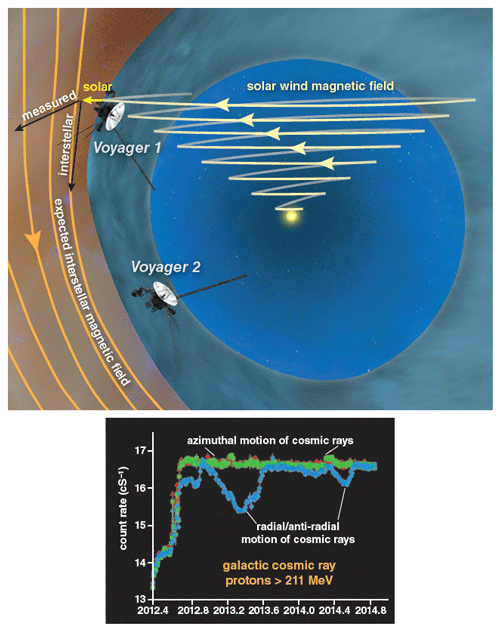
Although the plasma temperature cannot be measured, the high density is sufficient to prove that Voyager 1 has moved beyond the heliopause and is now indeed moving through the local interstellar medium. It must be noted that the sudden appearance of electron plasma oscillation was most likely due to solar activity back in March 2012, and the resulting plasma cloud arrived at Voyager 1 some 13 months later. In fact, a more detailed examination of the plasma wave antenna data revealed that similar, but lower, density oscillations were seen in the October–November time frame, most likely originating from earlier solar activity, that extrapolate into a crossing of the heliopause in late August 2012.
On September 9, 2013, we hosted a meeting at Johns Hopkins University of the entire Voyager team, at which the totality of the Voyager 1 observations was presented, analyzed, and contrasted with prevailing models. There was general agreement that Voyager 1 was, indeed, in the local interstellar medium and that the heliopause crossing took place on August 25, 2012, at a distance of 121.6 astronomical units (with light from the Sun taking 16 hours and 54 minutes to reach this distance), some 35 years after the spacecraft was launched from Cape Canaveral.
The galactic environment has not been the calm and benign regime that we all had expected.
After entering interstellar space, Voyager has continued to deliver surprises. The galactic environment has not been the calm and benign regime that we all had expected. Data on galactic cosmic ray intensities through the end of 2014 show that there exist periods of quiet isotropy, followed by incidents of anisotropy, as if an occasional “tsunami“ of activity perturbs the upstream medium after crossing the heliopause. These pressure waves most likely originate at the Sun, propagate through the heliosphere, and eventually arrive at the location of Voyager 1.
There is apparently a region beyond the heliopause, perhaps leading to a bow shock, beyond which the solar influence wanes. If so, that distance is at least 10 astronomical units away from the heliopause, where Voyager 1 is currently located (131 astronomical units from the Sun).
The odyssey of the two Voyagers, launched in 1977 and now on their 38th year in space, represents the epic mission of the space era. Voyager 1 has accomplished far more than its originators had any right to expect, and its journey of discovery has yet to end. The anticipated benign environment beyond the heliopause is anything but that so far, and new phenomena are revealed as it moves farther away. Voyager 2, at 108 astronomical units and 31 degrees south of the ecliptic, is currently exploring the heliosheath and there is no clear indication when it may cross the heliopause into the upstream region. It has the advantage of a working plasma instrument that will resolve some of the science questions raised by the Voyager 1 crossing, such as the temperature and directional flow of the galactic plasma. Also, Voyager 2 could conceivably answer the question of the existence of a bow shock, because Voyager 1 may not provide an unambiguous answer in the absence of plasma data.

The question comes up often about how long the Voyagers will last. The limiting factor is their radioisotope thermoelectric generators that convert heat from the radioactive decay of plutonium-238 into electrical current to operate the spacecraft and instruments. The half-life of plutonium-238 is 87.7 years, so the initial power at launch of 465 watts is now down to about 264 watts. In its current configuration, it is likely that Voyager 1 can fully power all its instruments through about 2020, at which time there will commence power-cycling of instruments. By about 2025, there probably will not be enough power to operate even one instrument, at which time Voyager operations are expected to cease. Although disappointing, it will be difficult to complain about the performance of these marvelous spacecraft, as the initial warranty of four years expired long ago.
It is often pointed out that Voyager did not leave the Solar System per se, but only the heliosphere, the ionized atmosphere of the Sun. Put another way, they escaped the region of the Sun’s chemical environment but not its gravitational environment. This distinction is strictly true, because the comets in the Oort cloud are loosely bound into solar orbit at distances up to 100,000 astronomical units. Note that Alpha Centauri, the nearest star to our own, is at about 280,000 astronomical units. At its present speed of 17 kilometers per second, Voyager 1 will pass a star named AC+79 3888, located in the constellation of Camelopardalis, in about 40,000 years. Even that will not be a very close encounter in Voyager’s long, lonely path.
It is unfortunate that none of the world’s space agencies are currently planning an interstellar probe as a follow-on to Voyager, even though the technology exists to attain at least 200 astronomical units in 25 years, and even 500 astronomical units in 50 years. Thus, knowledge gained by the Voyager mission is unlikely to be duplicated and advanced for at least another generation. We owe a tribute to the men and women of the latter part of the 20th century who built a wonderful set of spacecraft, and their current-day successors who have maintained and operated them for the benefit of human knowledge.
Click "American Scientist" to access home page
American Scientist Comments and Discussion
To discuss our articles or comment on them, please share them and tag American Scientist on social media platforms. Here are links to our profiles on Twitter, Facebook, and LinkedIn.
If we re-share your post, we will moderate comments/discussion following our comments policy.